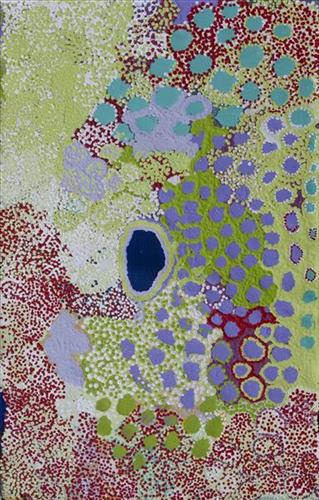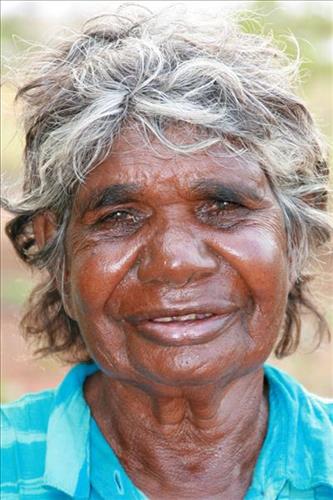111582307007
Taparl
“This is Taparl-taparl soak. The story is about an eagle who had two wives. He became jealous and he built the biggest fire. He put more and more wood on the fire until it was really enormous. The eagle turned into a rock, a black rock. One day I might show you this place, it’s really nice, you can clearly see the eagle in the rock, you can see the story.
Right next to the fire, the eagle’s two wives were fighting. The older wife was fighting the younger one and she fell into the fire and was burnt up. The eagle left with the younger wife. That was Taparl-taparl wanti (woman).”
– Yikartu Bumba, as translated by Ngalangka Nola Taylor
Taparl-taparl lies within Yikartu’s ngurra (home Country, camp), the area which she knew intimately and travelled extensively with her family in her youth. Yikartu walked around this Country with her grandmother, mother, father and grandfather all together. In her account, Yikartu describes part of a Jukurrpa (Dreaming) narrative occurring at this site; here the Taparl-taparl wanti argued with her sister-wife and their mutual husband.
Taparl-taparl is a soak located northeast of the Percival Lakes area, and at the northernmost boundary of Martu Country. Soaks, or soakwaters, derive their name from the manner in which their waters generally seep into the sand from below stores, sometimes as part of an ephemeral river or creek. Soaks were an especially important source of water during the pujiman (traditional, desert dwelling) era, being the most dependable water source in times of drought. Water was obtained from soaks by scooping away the sand with a piti (timber bowls used for carrying food and water) until clear water gathered at the base of the hole, sometimes at a depth of several metres.
During the pujiman period, Martu would traverse very large distances annually in small family groups, moving seasonally from water source to water source, and hunting and gathering bush tucker as they went. At this time knowledge of water sources was critical for survival, and today Martu Country is still defined in terms of the location and type of water. Each of the hundreds of claypans, rockholes, waterholes, soaks and springs found in the Martu desert homelands is known by name, location, quality and seasonal availability through real life experience and the recounting of Jukurrpa narratives.




